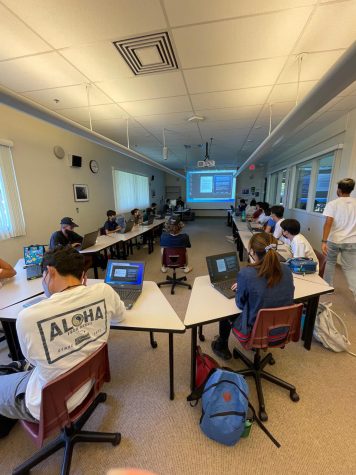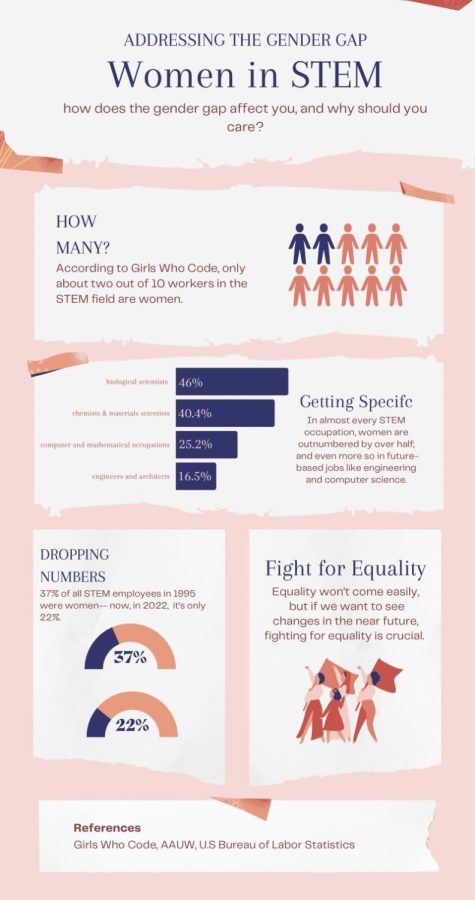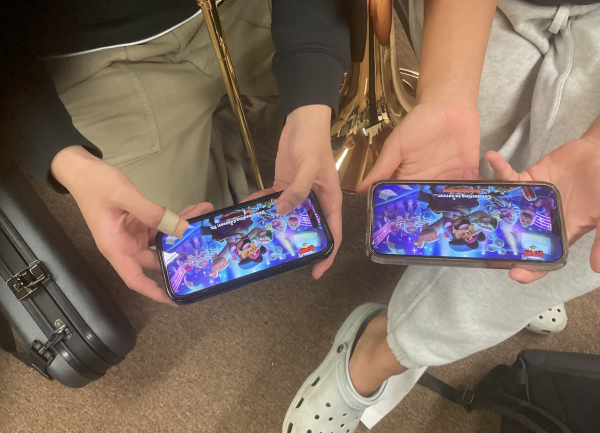Where are the women?
Infographic shows statistics depicting the number of women in STEM fields.
By Katie Troske
Staff Writer
We’ve painted the picture of a modern and inclusive world, yet the STEM gender gap continues to grow wider as less and less women get involved.
Stereotypes and enforced gender roles may sound like a thing of the past, but they still have an effect on children all around the world. Girls are often taught to be obedient and quiet, while boys aren’t made to be afraid of pushing past boundaries.
“The qualities that you need to be good at STEM are resilience, because you’re going to have to push through some problem solving. And so, from the very start, we are telling girls that they’re good if they don’t question, and that boys are good if they push through and if they problem solve and are resilient,” middle school Technology Teacher Jana Kaopuiki said.
Often, the pressure to conform to those gender roles comes from inside. Many women internalize the things they’re told, and that becomes the roadblock between them and the pursuit of their dreams and passions.
“You understand pretty early on that you’re not the norm; that you are something that looks different, that expresses yourself differently, that takes up different kinds of space. The confidence to know that you can do it sometimes falters because you know that you don’t fit into the role,” Kaopuiki said.
According to the University of Houston, stereotypes affect children as young as the age of six, and more than half of the surveyed children believe that subjects like computer science and physics are “boy subjects.”
Enforcing and instilling the idea from a young age that STEM is for everyone is crucial to diversifying the workplace and increasing the involvement of women in the STEM field.
“By the time I got to college, and I was into the tech stuff, I felt like it wasn’t a big deal that I was a girl. I was like, ‘Whatever. This is what I like, you know?’” Danelle Landgraf, the program head for technology and engineering at Mid-Pacific said.
At Mid-Pacific, the ratio of male and female are close, with 51% of the student population being male and 49% being female. Yet the class ratios are dramatically different—with sometimes as little as three girls in STEM-related classes.
“Look at the number of girls on the robotics team, or the number of girls in [Mid-Pacific’s] cybersecurity club. Previous to last year, there’s only ever been one girl on the team. Last year, I had three girls out of 20,” Landgraf said.

While efforts are being made to diversify the workplace and schools across the world, there’s always more to be done. Being able to recognize the progress we’ve made while focusing on what needs to be done is the first step towards a world of equality.
“I think there’s been a lot of effort involved to break down those barriers, but even if you look at our own CyberPatriot team or CyberOwls club, it is a male dominated club. So the question is why? And what do we do about that?” Director of Educational Technology Brain Grantham said.
The solution won’t be linear, but it’s crucial for girls of future generations to see people like them making changes in the STEM world, and to know that their voices will be heard.
Addressing and solving the gender inequality issues in the STEM field will be an uphill battle— but it’s a battle that’s worth fighting.
Girls Who Code is an organization that strives to create gender and racial diversity in the STEM field and has programs that reach thousands of girls and communities around the country.
STEM Like a Girl provides mentor-based workshops to encourage girls and families to get involved in STEM from a young age while remaining accessible and affordable to everyone.
Microsoft has been taking the steps to grant scholarships, provide affordable courses and experiences and engage an array of students in STEM.

Katie Troske is a senior and a fourth year journalist. She is also Na Pueo’s editor-in-chief this year. She likes going to the beach, hanging out with...








Patricia Troske • Mar 31, 2022 at 2:03 am
Katie this is wonderful articles. It blows me away at how thourjoughly you have explained this problem and how important it is to change this! This is very intelligently written! I am proud of you!